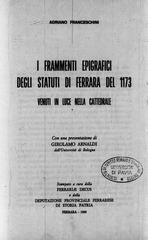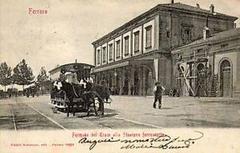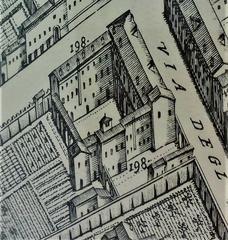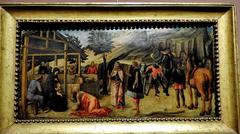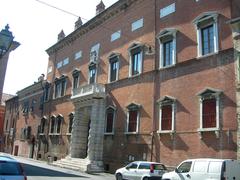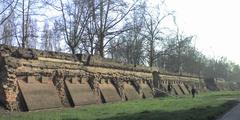Biblioteca Comunale Ariostea, Ferrara, Italy: Visiting Hours, Tickets, and History
Date: 14/06/2025
Introduction
The Biblioteca Comunale Ariostea, housed in the historic Palazzo Paradiso in the heart of Ferrara’s UNESCO-listed center, is a beacon of Renaissance heritage and a vibrant cultural hub. Renowned for its striking blend of Renaissance and Baroque architecture and its extensive collection of manuscripts, rare books, and historical documents, the Ariostea preserves the intellectual legacy of Ferrara and celebrates figures such as Ludovico Ariosto. This guide offers a detailed overview of the library’s significance, history, collections, visitor information, and tips for exploring Ferrara’s broader cultural landscape. (Wikipedia, Comune di Ferrara, archibiblio.comune.fe.it)
Historical Overview
Origins and Early Development
Built in 1391 for the Este family, the Palazzo Paradiso began as a noble residence before its transformation into an academic center. In 1567, Cardinal Ippolito II d’Este leased the building to university faculties, marking its shift toward education. The palace’s current appearance, with its iconic clock tower and marble portal, is the result of 17th-century renovations by Giovan Battista Aleotti. (Wikipedia, CERL)
Foundation of the Library
The Biblioteca Comunale Ariostea was founded in 1747 after the Este family relocated to Modena, taking Ferrara’s principal library and archives with them. The acquisition of Monsignor Bentivoglio’s library in 1750 and the donation of original Ariosto manuscripts provided the foundation for the new institution, which opened officially in 1753. (Museo Ferrara)
Growth and Cultural Significance
Through the 18th and 19th centuries, the Ariostea expanded via donations, bequests, and the absorption of materials from suppressed religious orders. By 1862, it achieved autonomy from the university and became the legal depository for all printed materials in the province, cementing its role as Ferrara’s principal public library. (Comune di Ferrara)
The Ariosto Legacy
Named for Ludovico Ariosto, the celebrated Renaissance poet, the library treasures autographed manuscripts of “Orlando Furioso” and other works. Ariosto’s tomb was transferred to the Palazzo Paradiso in 1801, and the main reading hall, Sala Ariosto, is dedicated to his memory. (Travelemiliaromagna, CERL)
Architectural and Artistic Heritage
The Palazzo Paradiso blends Renaissance restraint with Baroque grandeur. Notable features include its façade, clock tower, marble portal, a serene central courtyard, a grand Baroque staircase, and ornately decorated reading rooms. The garden, dedicated in part to Teresa Foscolo Foscari, offers a peaceful retreat. (Museo Ferrara)
The Library in the 20th and 21st Centuries
Throughout the 20th century, the Ariostea served as a meeting place for intellectuals. It adapted to social changes, such as the restoration of Giorgio Bassani’s library card after WWII-era exclusions, and embraced technological advances, including digitization and online services. Recent years have seen the acquisition of significant private archives, including those of Michelangelo Antonioni and Lanfranco Caretti. (Museo Ferrara)
Collections and Holdings
The library’s holdings number between 400,000 and 500,000 bibliographic units, encompassing manuscripts, rare books, incunabula, periodicals, maps, and local historical documents. Legal deposit status ensures continued growth and preservation of Ferrara’s written heritage. Highlights include Ariosto manuscripts, Bassani’s autograph of “Il giardino dei Finzi-Contini,” Este family records, illuminated manuscripts, and Renaissance scientific treatises. (Comune di Ferrara, Museo Ferrara)
Architectural and Artistic Features
- Façade and Clock Tower: Renaissance lines complemented by Baroque elements, including a marble portal and iconic clock tower.
- Courtyard: Central, two-story loggia with terracotta and stone accents, often used for cultural events.
- Grand Staircase: 18th-century Baroque staircase with frescoed walls and elegant ironwork.
- Sala Ariosto: The main reading hall, with a coffered wooden ceiling, frescoes illustrating Ariosto’s works, and rare bookcases.
- Frescoes and Stuccoes: 17th- and 18th-century decorative arts throughout the building.
- Ariosto’s Tomb: Neoclassical monument by Giannantonio Selva.
- Special Collections: Manuscripts, illuminated codices, Este court documents, portraits, and medals.
- Restoration Efforts: Ongoing projects ensure the preservation of both building and collections. (archibiblio.comune.fe.it)
Visitor Information
Location and Contact
- Address: Palazzo Paradiso, Via Paradiso 35 (or Via delle Scienze 17), Ferrara, Italy
- Phone: +39 0532 203481
- Website: Comune di Ferrara - Biblioteca Ariostea
Opening Hours
- Monday: Closed
- Tuesday to Friday: 9:00 AM – 7:00 PM
- Saturday: 9:00 AM – 1:00 PM
- Sunday and Public Holidays: Closed
Hours may vary during holidays or special events; check the official website before visiting.
Tickets and Admission
- General Admission: Free
- Special Exhibitions/Tours: May require advance booking or ticket purchase
Accessibility
- Fully wheelchair accessible with ramps and elevators.
- Dedicated facilities and assistance available upon request.
Guided Tours and Events
- Guided tours (in Italian, English, and other languages) available by appointment.
- Regular cultural events, lectures, and exhibitions; check schedules online.
Visitor Tips
- Photography allowed in public areas (no flash or tripods in sensitive rooms).
- Take time to appreciate the frescoes and the garden.
- Centrally located—combine with a stroll through Ferrara’s historic center.
Collections and Research
- Historical Manuscripts: Medieval codices, incunabula, Este family archives, and annotated works by Ariosto.
- Rare Books: Over 20,000 volumes, including illuminated manuscripts and early scientific treatises.
- Local History: City statutes, maps, Este decrees, and regional newspapers.
- Renaissance Studies: Specialized resources on Ariosto, Tasso, and other luminaries.
- Art, Music, and Science: Original musical scores, art treatises, and scientific works by pioneers like Galileo and Copernicus.
- Modern Holdings: Contemporary literature, local authors, and documentation of Ferrara’s ongoing cultural life.
Digital Resources
- Digital catalog and access to selected digitized materials via the library’s online portal.
- Virtual tours and online exhibitions.
Community and Cultural Engagement
- Events: Book presentations, reading festivals, educational workshops, and exhibitions.
- Partnerships: Collaborations with the Istituto di Studi Rinascimentali and local schools/universities.
- Educational Outreach: Guided tours, workshops, and research support.
- Inclusivity: Social programs and accessibility initiatives.
Nearby Attractions
- Castello Estense: Moated Renaissance castle.
- Ferrara Cathedral: Romanesque and Gothic masterpiece.
- Palazzo dei Diamanti: Renowned for its diamond-shaped façade and art exhibitions.
- Via delle Volte & Jewish Ghetto: Atmospheric medieval streets adjacent to the library.
Frequently Asked Questions (FAQ)
Q: What are the opening hours?
A: Tuesday to Friday, 9:00 AM – 7:00 PM; Saturday, 9:00 AM – 1:00 PM; closed Mondays, Sundays, and public holidays.
Q: Is there an entrance fee?
A: General admission is free; some exhibitions or tours may require tickets.
Q: Are guided tours available?
A: Yes, available by appointment in multiple languages.
Q: Is the library accessible to people with disabilities?
A: Yes, with full accessibility features.
Q: How do I get to the library?
A: Centrally located at Palazzo Paradiso, Via delle Scienze 17; walkable from Ferrara’s city center and accessible by public transport.
Q: Can I access library collections digitally?
A: Yes, through the online portal.
Preservation and Restoration
Active restoration projects safeguard the architectural integrity of Palazzo Paradiso and the conservation of rare materials. These efforts are part of Ferrara’s broader commitment to cultural heritage. (CERL)
Plan Your Visit
- Check the official website for updated hours and event schedules.
- Reserve guided tours in advance.
- Explore nearby Ferrara landmarks for a comprehensive cultural itinerary.
- Follow the library’s social media and download the Audiala app for guided tours and event updates.
Summary
The Biblioteca Comunale Ariostea stands as a cornerstone of Ferrara’s cultural and intellectual life, offering visitors access to centuries of literary, artistic, and historical treasures. Its blend of architectural splendor, priceless collections, and inclusive programming ensures a memorable and enriching experience for all. Plan your visit to immerse yourself in the Renaissance legacy and vibrant community of Ferrara.
